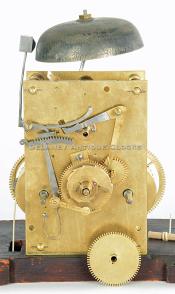Simon Willard. An inlaid mahogany case tall clock made in Roxbury, Massachusetts, circa 1790, a significant piece of American history that connects us to the craftsmanship of the past. YY-1.
This inlaid mahogany-cased tall case clock, an example of colonial era craftsmanship, was made by America's most famous clockmaker, Simon Willard of Roxbury, Massachusetts.
This handsome, tall clock epitomizes the formal "Roxbury" style cases that were so popular in Boston during the late 18th century. This borough of Boston became well known for providing clock cases with high-quality construction, pleasing proportions, brass stop fluting, and choice-figured mahogany. This representative example was produced by Boston's premiere clockmaker, Simon Willard. Simon was a prolific and innovative clockmaker and worked for a period that extended over sixty-five years. He trained many clockmakers that became famous in their own right. In addition, he built and sold clocks to some of our country's most prominent citizens.
This is a great-looking example. The shellac-based finish highlights the sweeping grain patterns exhibited in the mahogany wood. It also lights up the inlay details in the base and waist door. The case exhibits excellent proportions and stands on four ogee bracket feet. These are applied to the underside of the double-stepped base molding. A full inlaid patera is centered in the base panel. This oval inlay pattern with alternating fans of light and dark wood is a focal point of the base panel. The contrast is excellent. The waist section is long and narrow. It is fitted with a tombstone-shaped waist door trimmed trimmed with applied molding. An oval inlay featuring an urn is centered in the door. Brass-stopped fluted quarter columns flank the sides of the case. These terminate in brass quarter capitals. The bonnet features an open fretwork design. The three finial plinths are fluted along their length and capped at the top. Each supports a single brass ball and spire finial. Fully turned and brass stop fluted bonnet columns visually support the upper bonnet molding. These are mounted in brass capitals and are free-standing. The sides of the hood feature side lights or windows. These are fitted with glass. The arched bonnet door is fitted with glass. This door opens to access the dial.
The painted iron dial is signed "Simon Willard" in block lettering. The location of the signature is positioned just below the month calendar aperture. A moon phase or lunar calendar display is located in the arch of this dial. The lunar calendar or moon phase mechanism is a mechanical almanac and was most likely a special order due to the extra work involved in producing it. This display would have been valuable to a number of occupations during the colonial era. Farmers were known to track the phases of the moon. Periods of planting and harvesting were often scheduled around the full moon. Sailors and merchants track the lunar phases to know when the high tide would allow their ships to sail easily from a port or when the fishing might be best. Numerous religious groups had an almost superstitious litany of rituals that were best performed in accordance with lunar events. The actual lunar month represents an inconvenient interval of 29 days, 12 hours, 44 minutes, and 2.8 seconds. A tall clock's lunar calendar is set constant at 29.5 days, which represents a complete cycle. As a result, a 9-hour setback is required at the end of a single year to keep the lunar display current. The four corner spandrel areas of the dial are decorated with colorful floral patterns that are framed with gilt designs. This fine dial also displays the hours, minutes, seconds, and calendar dates in the traditional locations.
The clock movement is constructed in brass and is of good quality. Four-turned pillars support the two large brass plates. Hardened steel shafts support the polished steel pinions and brass gearing. The winding drums are grooved. The escapement is designed as a recoil format. The movement is weight-driven and designed to run for eight days on a full wind. It is a two-train or a time-and-strike design having a rack and snail striking system. As a result, it will strike each hour on the hour on a cast iron bell mounted above the movement.
This clock was made circa 1790 and stands approximately 7 feet 8.8 inches or 92.5 inches tall to the top of the center finial. The case is approximately 19.5 inches wide and 10 inches deep.
Inventory number YY-1.
Simon Willard was born in Grafton, Massachusetts, on April 3, 1753. He was the seventh of twelve children born to Benjamin Willard (1716-1775) and Sarah (Brooks) Willard (1717-1775) of Grafton. While living in Grafton, Simon answered the Lexington alarm on April 19, 1775, along with his brothers. It is thought that by 1782 he moved from Grafton and took up residence in Roxbury as a Clockmaker. Simon became a Master Clockmaker as well as an inventor. He is well known for receiving patents for his roasting jack in 1782, his "Improved Timepiece" or Banjo clock in 1802, and an alarm clock patent. In addition, he trained many men to make clocks who became well-known Clockmakers once their apprenticeships were served. Some of them include the brothers Levi and Able Hutchins, Elnathan Taber, William Cummens, Ezekiel Jones and Daniel Munroe. Some of the more notable public clocks Simon built include the clock in the United States Capitol building's Statuary Hall. He also built a clock for the House of Representatives and the U. S. Senate. Simon died on August 30, 1848, at the age of 95.














